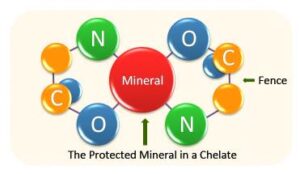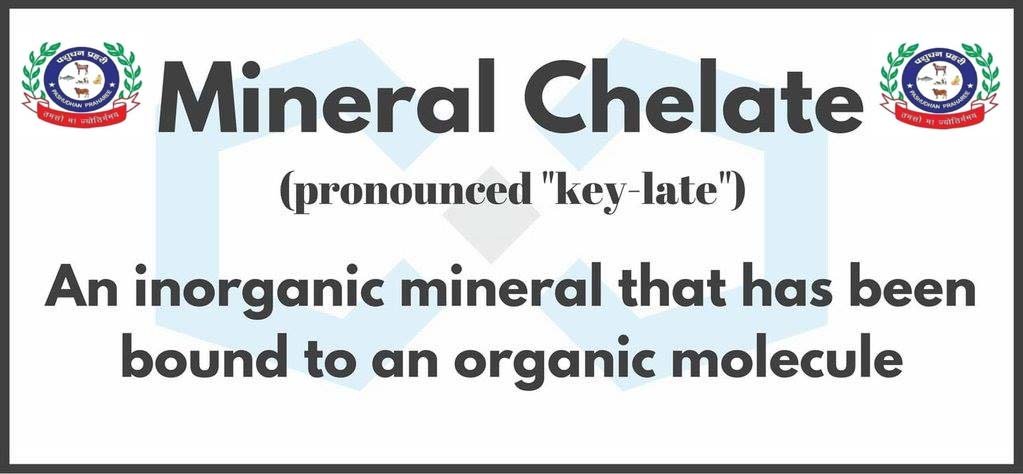CONCEPT OF CHELATED MINERALS IN ANIMAL NUTRITION
Post no-560 Dt-08/02/2018
Compiled & shared by-DR RAJESH KUMAR SINGH, JAMSHEDPUR, 9431309542,rajeshsinghvet@gmail.com
What are chelated minerals?
Chelates : It is a cyclic compound which is formed between an organic molecule and a metallic ion. Held with in the organic molecule as if by a “claw”.Chelate -Greek word – ‘Claw’
Complexing inorganic element with organic compound. This is called ‘Chelates’
“Chelated Minerals” is a way of presenting the essential trace minerals to the cow in a form that is more readily absorbed and utilized and not subject to the same interactions commonly experienced with inorganic elemental forms. This chelation process involves the chemical bonding of the trace mineral to an amino acid(s) or small peptides.
Chelation refers to a bonding formed between a metal ion (mineral) and ligand (protein or amino acid). A mineral complex is a mixture of the mineral and organic compound. The biological role of chelated trace minerals is important. To be beneficial in dairy cows, the product should be stable in the rumen and digestive tract. Absorbed chelated minerals could stimulate certain physiological responses or enter target tissues at higher levels.
Technology for preparation of chelated minerals—–
Hydrolysis of Protein+Separation by centrifuge and ultrafiltration +Chelation process+Removal of unbound mineral+Drying grinding and storage
Mode of action
Stable in rumen environment & abomasum
Delivered in small intestine as such.
Absorbed through active transport (more blood level)
It act as biological complex (more tissue level)
Enter into different pool
Metabolizable in differently(Neathery et al 1972) (Pharmaco-dyanamics nutrient) (using 65Zn)
Factors influencing stability of minerals in the rumen——
1. Charge / radius :
2. Neural binder – more polar – Higher tendency to coordinate metal ion.
3. Alkaline binder – Stabilization by formation of covalent bond
4. Chelation effect :
1. Mono dentate – less stable
2. Multi dentate – more stable
5. Dimensions of Chelation :
6. Shape: Steric Tension—High stability
Use of chelates in Animal Nutrition
Main Objectives :
1. Reduction of antagonism, interferences and competition among minerals.
2. Improve the bioavailability of minerals
3. Counteract antinutritional factors, which affecting minerals
4. Performance improvement
5. Health improvement (immune status, functional nutrition)
6. over all animal welfare
7. Improvement in animal produces quality (meat, milk, egg, wool etc.,)
8. Reduce degenerative effect of trace minerals on vitamins in premixes and feed.
9. Protect environment by reducing metal pollution.
Chelation Process
Chelation, which literally means, “bringing together,” refers to a bonding formed between a metal ion (mineral) and a ligand (protein or amino acid chelating agent) carrier. A mineral complex is a mixture consisting of a mineral and an organic compound carrier, such as a protein or polysaccharide; a chelate is a type of complex. Chelates are generated by reacting a mineral salt with, for example, an enzymatically prepared mixture of amino acids and small peptides, under controlled conditions. The ligand binds the metal at more than one point such that the metal atom becomes part of a ring. Certain amino acids and protein digestion products such as small peptides are ideal ligands because they have at least two functional groups (amino and hydroxyl) that can form a ring structure with the mineral. The resulting mineralorganic complex is a “chelate.” The primary chelated minerals used in animal feed are the trace elements iron, manganese, cobalt, copper, and zinc. These “Transitional Elements” on the Periodic Table have chemical characteristics intermediate between metal and non-metal elements. Transitional elements prefer to form coordinate covalent bonds, a hybrid form of linkage that gives them their unique ability to form stable complexes– coordination complexes or chelates
Specific Uses
Chelates and other complexes are useful in animal nutrition to protect trace minerals during digestion. The goal of forming chelates is to increase the bioavailability of minerals to the animals to support metabolic functions. Chelated and other complexed minerals are administered especially during times of high nutritional demand, such as pregnancy, weaning, or other reproductive stress, rapid growth, environmental stress (such as moisture, heat, or humidity), or health stress. Chelates have been studied with regard to their effect on improved immunity (less disease or sickness), reproductive performance and herd health.
Action—
Solubility is critical for trace mineral absorption. To maximize uptake, chelates and other complexes should be stable in the rumen and digestive tract of animals. Chelates are stable, electrically neutral complexes, which protect trace minerals from chemical reactions during digestion that would render the mineral unavailable to the animal. When inorganic mineral compounds, typically in oxide or sulfide form, are released and ionized in the stomach’s low pH, the electrically charged forms of the minerals are able to react with other products of digestion. Complexes with naturally occurring organic ligands must form if absorption is to occur. However, the formation of insoluble, unavailable substances may also result, especially in the small intestine, when pancreatic bicarbonate restores a higher, more neutral pH. Added minerals precomplexed with organic ligands thus are used to increase bioavailability and uptake. The chelated mineral reaches the plasma intact and separates at the site of action.
The benefits of feeding Chelated Trace Minerals include:
• Improved fertility and reproductive performance • Reduced somatic cell counts • Increased hoof strength • Improved immune status • Improved performance in growing animals • Reduced mortality and ill health How to feed Chelated trace minerals? Chelated trace minerals are suitable for use in all species. They can replace 25-40% of the supplementary inorganic minerals as a means of providing highly available trace minerals. Soluble Chelated trace minerals are specially formulated for drinking water supplies. Some of the scientifically proven benefits of Chelated trace minerals include; • Cattle, Sheep and Goat: Improved performance, reproductive efficiency, hoof health and milk production with lower somatic cell counts. • Pigs: Improved sow productivity, growth rates and feed efficiency with reduced mortality. • Equine: Improved hoof growth and integrity and skeletal development, better reproductive efficiency and enhanced immune function.
The advantage of Invitro Mineral Chelation
Chelation —-enhances bioabsorption because the organic form is recognized as peptide or amino acid. Chelation —-protects mineral in adverse medium.
Chelation —protects minerals from incompatibility situation in presence of antagonistic elements. Chelation —–makes minerals pH stable and electrically neutral.
Chelation —-improves tissue mineral retention and activity.
Chelation —makes specific tissue targeting of minerals possible, e.g. , If Zinc is chelated with methionine it will be targeted to hooves, skin epithelial tissue regeneration and hair where it is needed in large quantities.
Chelation—- is proven to be beneficial in situations like reproductive problems, stress and rations with various interfering substances such as phytin, where ordinary trace minerals supplementation fails. Adding essential trace minerals in chelated form is a proven useful means of solving several practical problems. Below is a brief discussion of practical situations where mineral chelates could be useful.
Infertility: —-The process of pregnancy is dependent on essential trace minerals, which influence immune system, hormonal patterns and the integrity of regenerated cellular epithelium. The latest evidences also suggest that originally bound trace minerals may have a beneficial role to play in resumption of follicular growth and fertility in dairy cows. The trials with chelated minerals supplementation during the first 100 days following parturition has been shown to increase fertility in dairy cows through increased conception rate and improved embryonic survival. The improved reproduction by chelated mineral supplementation results from: ! Reduced embryonic death loss ! Improved uterine environment ! Reduced incidence of cystic ovaries ! Increased intensity of oestrous behaviour.
Mastitis: —-Numerous trials have demonstrated that organically complexed Zinc and Selenium can reduce somatic cell counts in dairy cows. The role of zinc is regeneration of keratin which maintains the integrity of the udder lining and protecting the mammary gland from infection. It has been shown that 50% of the teat keratin can be lost in each milking, which needs to be regenerated. The synthesis of teat keratin may be controlled by the amount of bioavailable zinc in the diet. Whereas Selenium as an integral part of the glutathione peroxidase enzyme acts biosynergestically with Vitamin E as biological antioxidant to improve the rapidity of influx of polymorphonuclear neutrophilis and their phagocytic activity. This reduces somatic cell counts and reduces incidence of mastitis.
Hoof Problems:—-Lameness and sore feet have been demonstrated to reduce milk production by affecting the cow and mobility. Improving hoof quality with Zinc supplementation has shown to reduce stress in animals and improve production
Points to remember: !
Minerals should not be offered as a free choice, rather these should be force fed daily in compounded feed/ complete feed to all categories of animals.
! Mineral supplement should be area specific keeping in mind status of minerals in soil and type of feed/forages of the region.
! Diet should not be deficient in other nutrients specifically energy, protein and some of vitamins like A, D and E.
! Minerals should be supplemented keeping in view the production/reproduction status of the animal.
! Never over-feed the minerals especially beyond tolerance levels.
! Reduce the supplementation of mineral mixture, especially that of Ca, during transition period (last phase (2-3 wks) of pregnancy.

Reference-On Request



